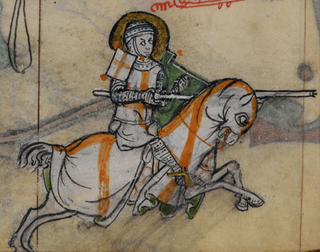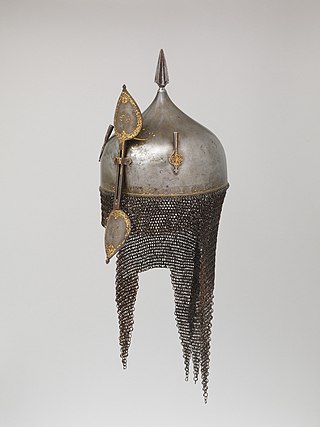
Armour or armor is a covering used to protect an object, individual, or vehicle from physical injury or damage, especially direct contact weapons or projectiles during combat, or from a potentially dangerous environment or activity. Personal armour is used to protect soldiers and war animals. Vehicle armour is used on warships, armoured fighting vehicles, and some combat aircraft, mostly ground attack aircraft.

A shield is a piece of personal armour held in the hand, which may or may not be strapped to the wrist or forearm. Shields are used to intercept specific attacks, whether from close-ranged weaponry or projectiles such as arrows, by means of active blocks, as well as to provide passive protection by closing one or more lines of engagement during combat.

The katar is a type of push dagger from the Indian subcontinent. The weapon is characterized by its H-shaped horizontal hand grip which results in the blade sitting above the user's knuckles. Unique to the Indian subcontinent, it is the most famous and characteristic of Indian daggers. Ceremonial katars were also used in worship.

The talwar, also spelled talwaar and tulwar, is a type of curved sword or sabre from the Indian subcontinent.

Chinese armour was predominantly lamellar from the Warring States period onward, prior to which animal parts such as rhinoceros hide, rawhide, and turtle shells were used for protection. Lamellar armour was supplemented by scale armour since the Warring States period or earlier. Partial plate armour was popular from the Eastern and Southern dynasties (420–589), and mail and mountain pattern armour from the Tang dynasty (618–907). Chain mail had been known since the Han dynasty, but did not see widespread production or battlefield use, and may have seen as "exotic foreign armor" used as a display of wealth for wealthier officers and soldiers. During the Ming dynasty (1368–1644), brigandine began to supplant lamellar armour and was used to a great degree into the Qing dynasty (1644–1912). By the 19th century most Qing armour, which was of the brigandine type, were purely ceremonial, having kept the outer studs for aesthetic purposes, and omitted the protective metal plates.

The Juti or Jutti is a type of footwear common in North India, Pakistan, and neighboring regions. They are traditionally made up of leather and with extensive embroidery, in real gold and silver thread as inspired by royalty in the subcontinent over 400 years ago. Prior to that, Rajputs of the northwest used to wear leather juttis, also called ethnic shoes. Now with changing times, different juttis with rubber soles are made available. Today Amritsar and Patiala are important trade centers for handcrafted juttis, from where they are exported all over the world to Punjabi diaspora. Closely related to Mojaris. Jutis have evolved into several localized design variations, even depending upon the shoemaker. However by large, they have no left or right distinction, and over time take the shape of the foot. They usually have flat sole, and are similar in design for both women and men, except for men they have a sharp extended tip, nokh curved upwards like traditional moustaches, and are also called khussa, and some women’s jutis are backless. Even with changing times jutis have remained part of ceremonial attire, especially at North Indian weddings, the unembellished juttis are used for everyday use for both men and women in most of Punjab, mostly called Jalsa Jutti which is blackish in color.

The ailette was a component of late thirteenth and early to mid fourteenth century knightly armour. Usually made of cuir bouilli, ailettes were thick, quadrangular pieces of leather or wood that attached to the shoulders by means of silk or leather cord. Ailettes were usually flat and nearly rectangular in shape, and usually decorated with heraldic designs.

The Skeleton in Armor is the name given to a skeleton associated with metal, bark and cloth artifacts which was unearthed in Fall River, Massachusetts in 1832. The skeleton was subsequently destroyed in a fire in 1843. It is also the name of a poem by Henry Wadsworth Longfellow.

A shotel is a curved sword originating in Eritrea and northern Ethiopia. The curve on the blade varies from the Persian shamshir, adopting an almost semicircular shape. The blade is flat and double-edged with a diamond cross-section. The blade is about 40 inches (1 m) in total length and the hilt is a simple wooden or rhinoceros horn piece with no guard similar to the jile or jambiya. The shotel was carried in a close fitting leather scabbard which was often decorated in precious metals and worn on the right side.

Sangu is the term for the three armour components that protected the extremities of the samurai class of feudal Japan.

Shibchar is an upazila of Madaripur District in the Division of Dhaka, Bangladesh.

The European buff coat is an item of leather clothing that was primarily worn by cavalry and officers during the 17th century, but also worn by a small number of infantry. It was often worn under iron or steel armour for the torso. The buff coat was derived from the simple leather jerkins employed by huntsmen and soldiers during the Tudor period, these in turn deriving from the arming doublet. The name of the jacket, as well as its characteristic tan or buff colour, derives from the buffalo or ox hide from which it was commonly made.

The pesh-kabz or peshkabz is a type of Indo-Persian knife designed to penetrate mail armour and other types of armour. The word is also spelled pesh-qabz or pish-ghabz and means "fore-grip" in the Persian language; it was borrowed into the Hindustani language. Originally created during Safavid Persia, it became widespread in Central Asia and the Indian subcontinent during Mughal period.

Mughal weapons significantly evolved during the ruling periods of its various rulers. During its conquests throughout the centuries, the military of the Mughal Empire used a variety of weapons including swords, bows and arrows, horses, camels, elephants, some of the world's largest cannons, muskets and flintlock blunderbusses.

Native American weaponry was used by Native American warriors to hunt and to do battle with other Native American tribes and Europeans.

The piha kaetta, also sometimes called 'the Kandyan knife', is a knife or dagger native to the island of Sri Lanka. A typical piha kaetta has a straight-backed blade combined with a drop-point and a curved cutting edge. Many of the finest piha kaetta knives were produced in royal workshops, show very high levels of craftsmanship, and were given to courtiers and the nobility as status symbols.

The turban helmet or Tolga in Turkish, is a historical variety of combat helmet with a bulbous shape and fluting that imitates the folds of a turban. Turban helmets originated in Ottoman Turkey, primarily used by warriors and some non-Turkish auxiliaries.

Kulah Khuds were used in ancient western Asia for battle and as decorative head pieces.

A toradar is a South Asian matchlock primarily found in the Mughal Empire, dating from the 16th century. It was a preferred firearm in India well until the mid-19th century because of its simple and cheap design.

Armor in the Indian subcontinent was used since antiquity. Its earlier reference is found in the Vedic period. Armor has been described in religious texts; including the Itihasa epics Ramayana and Mahabharat, as well as in the Puranas.





















